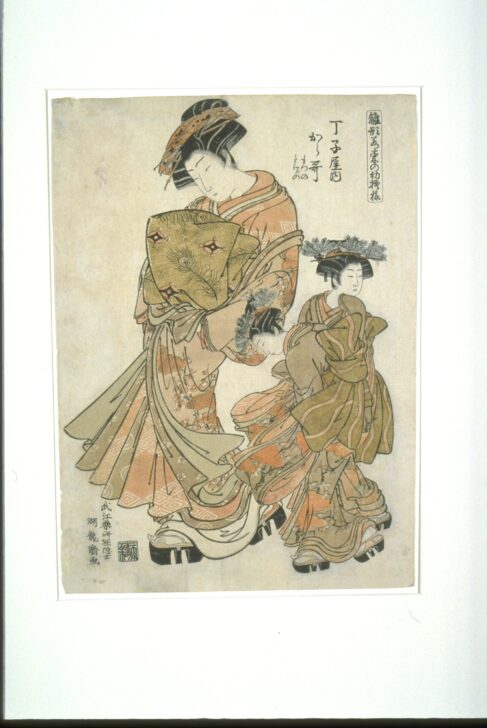First Designs of Model Young Leaves: the Courtesan Karauta of the Chôjiya, accompanied by her attendants Matsuno and Takeno
Isoda Koryūsai

Description
This stunning print, in superb condition, is from one of the most famous print series by Koryûsai. Issued in the late 1770s or very early 1780s, First Designs of Model Young Leaves (Hinagata wakana no hatsu moyô) definitively marks Koryûsai’s independence from Harunobu, who had so long inspired his work. Harunobu's girl-next-door type of beauty is gone, as is his detailed architectural setting. Instead we are back to a grandly idealized rendering of a courtesan, here identified by name for the first time.
Traditionally the famous beauties of the Yoshiwara entertainment quarter in Edo would parade under the cherry blossoms every spring in the newest fashions. Here we are shown the reigning courtesan of the Chôjiya house, Karauta, accompanied by two young attendants, Matsuno and Takeno, in matching costumes. Note the new "lantern" hairstyle, with the broad wings to the side of the head. This print serves as an advertisement for the attractions of the Chôjiya tea house— and quite possibly for the shop that provided the costumes as well. Print designers often worked as textile designers on the side, and images such as these would appeal to women as the equivalent of the latest issue of Vogue.
M. Graybill
"Courtesans, Cross-Dressers, and the Girl Next Door Images of the Feminine in Japanese Popular Prints"
3/9 - 9/1/02
From the series Hinagata wakana no hatsu moyô (First Designs of Model Young Leaves)
Signature: Mukô Yagenbori onshi Koryûsai ga
Publisher's seal: Eijudô.
Dealer's seal on back of paper.
Traditionally the famous beauties of the Yoshiwara pleasure district would parade every spring in the newest fashions. Here we are shown the reigning courtesan of the Chôjiya house, Karauta, accompanied by two young attendants, Matsuno and Takeno, in matching costumes. Note the new "lantern" hairstyle, with the broad wings to the side of the head. This Koryûsai print served as an advertisement for the Chôjiya teahouse and quite possibly for the shop that provided the costumes as well. Print designers often worked as textile designers, and images such as these would appeal to Edo-period women as the equivalent of the latest issue of Vogue.
(Label for UMMA Japanese Gallery Opening Rotation, March 2009)
a mythical font of eternal youth, in distant China
the river that flows by Yoshiwara
a famous twelfth-century monk who was, in legend, intimate with a great courtesan
Subject Matter:
Traditionally the famous beauties of the Yoshiwara entertainment quarter in Edo would parade under the cherry blossoms every spring in the newest fashions. Here we are shown the reigning courtesan of the Chôjiya house, Karauta, accompanied by two young attendants, Matsuno and Takeno, in matching costumes. Note the new "lantern" hairstyle, with the broad wings to the side of the head. This print serves as an advertisement for the attractions of the Chôjiya tea house— and quite possibly for the shop that provided the costumes as well. Print designers often worked as textile designers on the side, and images such as these would appeal to women as the equivalent of the latest issue of Vogue.
(Adopted from M. Graybill, "Courtesans, Cross-Dressers, and the Girl Next Door Images of the Feminine in Japanese Popular Prints" 3/9 - 9/1/02)
Physical Description:
This is a color woodblock print of a courtesan and her two attendants. They are walking toward the left. The courtesan wears red and brown kimono with geometric designs and a pink cloak with plum tree and cloud design. Her green obi (sash), tied in front, has peacock feather and geometric patterns. Her hair is sculpted in the shape of “lantern” style, with the broad wings to the side of the head. Three large tortoise-shell comb and four pins adorn the hair. The two young attendants wear matching clothes and hair accessories; their kimono design has the same plum and cloud patterns as the courtesan but in brownish colors. Their obi is in green color with wavy stripes, loosely tied on their backs. They also have tortoise shell combs, hairpins, and ornaments in the shape of pine leaves. One attendant is looking at a ground, and other attendant toward the right. All three wear high platform sandals. There are artist’s signature and publisher’s seal on the lower left corner, as well as the title on the upper right corner.
Usage Rights:
If you are interested in using an image for a publication, please visit https://umma.umich.edu/request-image/ for more information and to fill out the online Image Rights and Reproductions Request Form.